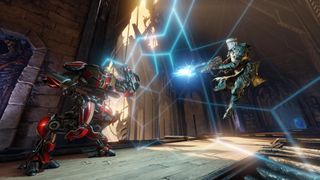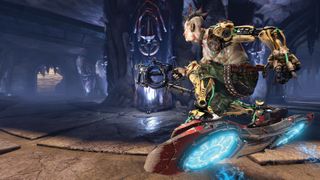Quake Champions aims to bring characters to id's arena shooter, will it succeed?
Creative director Tim Willits discusses Quake and the "natural evolution of the genre."

This article was originally published in PC Gamer issue 296. For more quality articles about all things PC gaming, you can subscribe now in the UK and the US.
I’m at QuakeCon, surrounded by id Software’s most dedicated fans, watching the first footage of the studio’s next game. A cheer goes up from the crowd. I imagine it’s a relief for id. If Quake Champions doesn’t get a pop from a QuakeCon crowd, something’s badly wrong.
It wasn’t a sure bet, because this isn’t a typical arena shooter. Like Overwatch and Team Fortress 2, Quake Champions is a multiplayer FPS with characters, each with a unique ability. And yet, as the QuakeCon footage reveals, Quake Champions still looks, feels and, as far as I can tell, plays like Quake. “Seriously?!” exclaims Tim Willits, id’s creative director, when I ask him why now is a good time for Quake’s return. His expression suggests I’ve just asked why now might be a good time to hug your child—as if there could never be a bad time for a Quake comeback. And fair enough, I understand his enthusiasm for the series. But seriously, why now?
“Things have never been better,” Willits says. “It’s amazing—Doom was so awesome that it made making Quake way easier. There’s just a lovefest at the studio right now.” It sounds as if id was reinvigorated by Doom’s success. The critical and fan acclaim must have been a huge morale boost after what seemed to be a troubled development. “With Doom,” Willits continues, “the studio really hit on the core fundamentals of what people enjoyed about the franchise. So with Quake, we want to keep the scope tight; the focus tight—that’s why it’s PC only. We want to do the best competitive multiplayer game that we can.”
Certainly the timing seems right for a game of Quake Champions’ scope. Indie projects such as Ratz Instagib, Xonotic and Warsow, as well as Epic’s new Unreal Tournament, show there are still communities hungry for ’90s-era multiplayer action. And the emergence of Overwatch, Battleborn and Lawbreakers would seem to suggest the hero shooter is the next big thing. Quake Champions is id Software’s attempt to bridge the gap between old and new.

“I believe the reason you see a lot of heroes, champions—whatever you want to call them—is it’s a natural evolution of the genre,” says Willits. “Gamers want a little bit more depth. They want to feel a little bit more connected to a particular character. Everyone has a different playing style, and it doesn’t detract from the pure shooting and the speed; the rocketjumping and rail-shooting and stuff. But it definitely adds a more enjoyable layer on it. It’s just more strategy, and more depth.”
Quake Champions was first planned as a possible expansion to id’s Quake Live—the updated version of Quake III Arena that was, for a time, free-to-play. “We were looking at how we could evolve [Quake Live],” Willits says, “and we started—because we were just a small team—to think about ways of adding the champions into Quake Live. I actually registered QuakeChampions.com myself in 2013.”
The biggest gaming news, reviews and hardware deals
Keep up to date with the most important stories and the best deals, as picked by the PC Gamer team.
There are no weapon loadouts or limits—each champion is able to pick up any and every weapon from the map.
Willits and his team pictured the champions as an “additive layer” to Quake Live—a term he still uses to describe Quake Champions’ action. “We did prototyping and a lot of experimentation, but then we looked at how Doom was shaping up. It was looking awesome. We found a developer in Saber Interactive that’s been helping us, and we were like, ‘We could make this all with new tech.’ The Quake Live engine was the Quake III engine, and that came out in 1999!” And so Quake Champions was reborn as something new.
Tim’s major focus during the opening QuakeCon keynote was on how Quake Champions “stays true to the legacy” of the series. There are no weapon loadouts or limits—each champion is able to pick up any and every weapon from the map. There are health pickups, power-ups and jump pads. Movement and momentum remain key, with bunny hops and rocket jumps playing a big role in how you make your way across a map. Even the guns will be familiar to Quake fans—returning favourites such as the railgun, gauntlet, lightning gun and nailgun are all present and correct.
On top of everything that remains classic Quake, id adds the champions. It’s not just that each character has a different ability, but that each has varying movement speed and maximum health. On stage at QuakeCon, we’re shown one of the champions, Ranger, performing a series of strafe jumps across the map. At one point in his platforming chain, Ranger is forced to use a rocket jump to clear a particularly wide gap. Next, we see another champion, Anarki, attempt the same route. He’s able to cross the course with strafe jumps alone. “Anarki has more of a QuakeWorld air-control feel,” Willits says. “He’s faster, but he also has slightly less health and armour. There are some people that strafe-jump everywhere, some people who’re really into air control, and there are some gamers that never strafe jump. They usually die a lot.”

The champions are specced around the varying playstyles of Quake fans, and the differences between past games. “Literally all of the Quake games,” Willits affirms. “QuakeWorld had a lot of air-control. Air-control then went away in Quake 2, but we had different rocket speeds and knockback. And people play differently. Some people bunny hop, some don’t. We were kind of focused-in on what people do across the different Quake games.” Abilities are a little broader in scope, but work to complement each champion’s optimal playstyle. Ranger, the original Quakeguy, carries a Dire Orb. He can throw it and teleport to its position—a reference to Quake 1’s telefrag boss kill. Other champions are less direct. Sorlag—a returning character from Quake III—has an acid spit ability. Her primary use is crowd control and area denial. “She’s really great for dropping the acid on the power-ups,” says Willits, “especially because we have the timers we had in Quake Live, so you can time it.”
More interesting are the abilities designed to help those players who do die a lot. Galena can drop totems that heal her and her teammates. Anarki can heal himself. Every time he does, his maximum health pool rises. This is what I’m interested in, and what still gives me some cause for concern: how well do healing champions work in a series that, traditionally, has required map knowledge to find and collect health and armour pickups?
On the one hand, Quake Champions doesn’t go full Overwatch. It seems each champion only has the single ability, meaning the differences between each aren’t quite as pronounced. On the other, it is definitely a departure from Quake games of old. I ask Willits whether the continued support for Quake Live allows id to take more risks with Champions. “We’re pretty cautious,” he says. “Trust me! We cannot screw this up!” And yet, he sounds confident that id has found the right balance. “Our Quake fans want their Quake sauce,” is how he puts it. “But they’re OK with some sprinkles around the edges. It hasn’t been that difficult because [the champions] don’t play completely different.”
Despite this, your champion pick may not simply be a matter of player preference. While that’s certainly an important element—unlike in Overwatch, you shouldn’t be pressured into picking a specific character because nobody else wants to play the support—Willits does hope players will think through how a team fits together. “I hope team composition comes into play, and it already does at id when we play,” he says. “Especially with Visor.” A returning face (or, more accurately, mask) from Quake III Arena, Visor’s special ability is Piercing Sight, which lets him see enemies through walls.
“We ran some playtests, and there’s some people who are like Visor won’t need Piercing Sight to see this coming.‘Visor’s OP’ and then there’s some people who are ‘Visor’s useless’. That’s so interesting how you can get an active ability like that—and he does Piercing Sight for just two or three seconds—and the perception, based on what the team is doing, can really change the perception of a single character.”

Phil has been writing for PC Gamer for nearly a decade, starting out as a freelance writer covering everything from free games to MMOs. He eventually joined full-time as a news writer, before moving to the magazine to review immersive sims, RPGs and Hitman games. Now he leads PC Gamer's UK team, but still sometimes finds the time to write about his ongoing obsessions with Destiny 2, GTA Online and Apex Legends. When he's not levelling up battle passes, he's checking out the latest tactics game or dipping back into Guild Wars 2. He's largely responsible for the whole Tub Geralt thing, but still isn't sorry.
Most Popular



